It’s CPI Day and, possibly, mea culpa day.
Last month I, and almost everyone else, said the peak was behind us as it dropped from 8.5% to 8.3%. In fact, I went out of my way to be sure people understand that peak CPI doesn’t mean peak prices.
We may have been premature. Today, while the consensus estimate was that headline would print 8.3% Y/Y, it came out at 8.6%—the highest in 40 years.
Of course, that is because gasoline prices did not peak and kept on climbing. The national average is about to surpass $5/gallon. And this is keeping the headline inflation bid.
And I focus on Median CPI, which is still rising. It will keep going up for at least a few more months. And this is the salient point. Median is the best measure of the main thrust of the distribution – and while it’s rising, you can’t say price pressures have peaked yet.
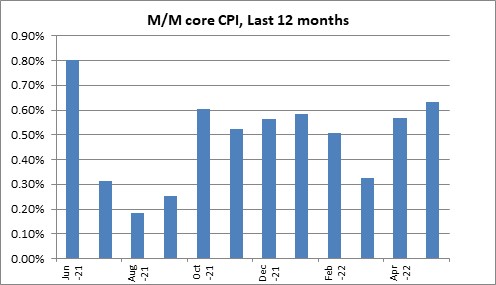
Core CPI M/M
In the bad news category this month, new cars and apparel are likely to continue to be contributors. Used cars are a little less clear. But these are three of the big “core goods.” So it isn’t just used cars. It was never just used cars, of course. That was just a foil.
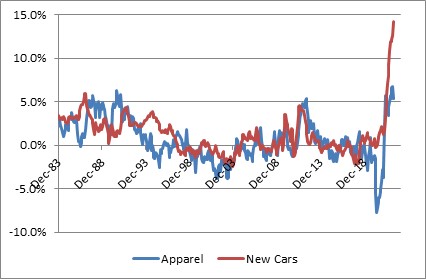
Used/New Car Prices
Also, in the bad news category for the general inflation outlook (although not for this month’s CPI, perhaps) is that wages are still accelerating. The Atlanta Fed Wage Growth Tracker is now up at 6.1% y/y.
The good news is those wages are maintaining a steady spread over the median CPI. The bad news is that, so far, gasoline and food aren’t mean-reverting, and so the wage slaves of the world (and that’s most of us) are still getting killed. But maybe après le deluge things will be better.
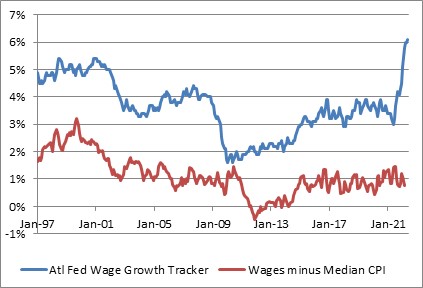
Atl Fed Wage Growth/ Wages Minus CPI
Hey, the good news is that M2 is decelerating. It’s down to 8% y/y, and only 1-2% over the last 3 months. The problem is that prices still haven’t caught up with the money growth so far, but at least maybe we’re stopping the digging of the hole. Early to say that yet.
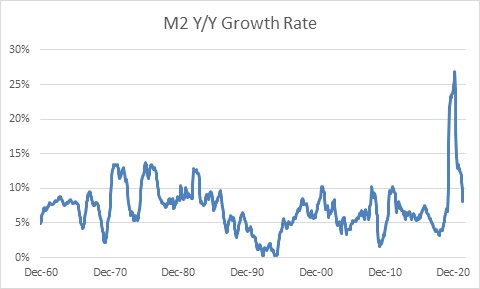
M2 Money Supply Year-On-year
Unfortunately, commercial bank credit is growing at 9.5% y/y, which is exactly what you would expect when non-reserve-constrained banks are able to lend at higher market rates.

This is one of the mechanisms for velocity rising when rates go up: the credit supply gets better, and the demand for credit is fairly inelastic (50bps means more to your bank than it does to you).
We have never ever tried to restrain inflation with rates alone. Repeat that to yourself: monetary policy-makers have never tried to restrain inflation to anything like this level with just interest rates. In the past, they restricted reserves. Not this time. So, here’s hoping.
Pretty short walk-up today, but that’s because all the stories are the same: rents and breadth, and we are still looking for a peak. Rents still look strong, breadth is still wide, and the peak in headline and median appears to be ahead still.
The question to ponder is: if CPI hits a new high, how bad for equities is that? If inflation stays at 6% for 2022, how long can the Fed sell the idea that 2.75% is the highest they’ll need to hike? The euro dollar curve doesn’t believe it, but it also thinks this is all over in 2023.
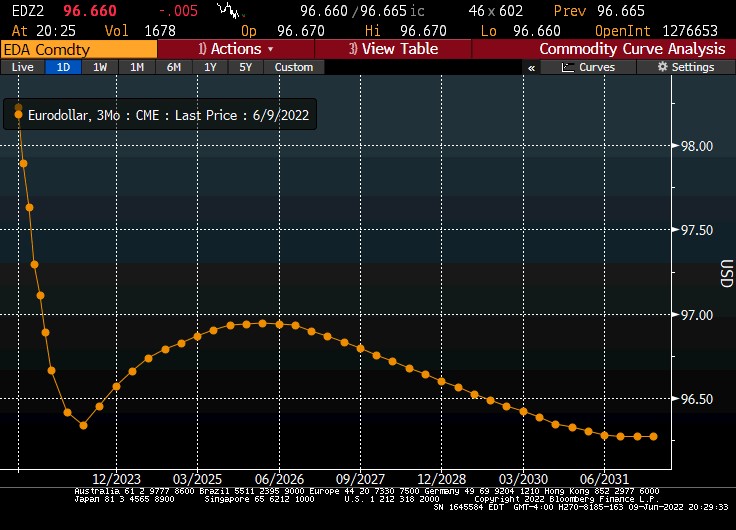
I’m still thinking the Fed will pause the first time stocks get sloppy, or unemployment starts to rise, but maybe I’m wrong. So far, no signs of that. Still, they’ve not been tested yet.
I guess we weren’t at peak CPI yet. M/M headline +1%; Y/Y up to 8.6%. The core slipped, but not as far as expected to 6.01%. The decline in base effects. The bad news is that this is the highest m/m core CPI since last June.
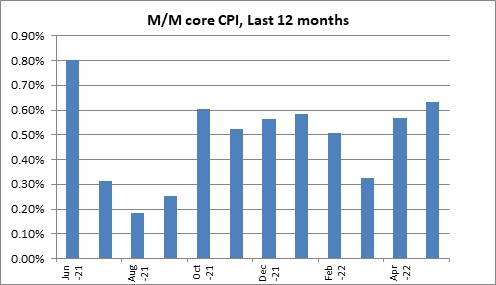
Core CPI M/M
It wasn’t just gasoline helping the headline to new highs; Food & Beverages was +1.13% m/m, now up to +9.73% y/y again, that hurts the wage earners most.
Used cars was +1.8% m/m. New cars +0.96% m/m. Airfares, after +19% last month, were +12.6% this month. And can I say the quality of air travel is as bad as I can remember it, speaking anecdotally.
Remember how everyone said that when core goods inflation came down, this would pass? Well, it is! Core goods fell to 8.5% y/y from 9.7%. But core services jumped to 5.2% from 4.9%.
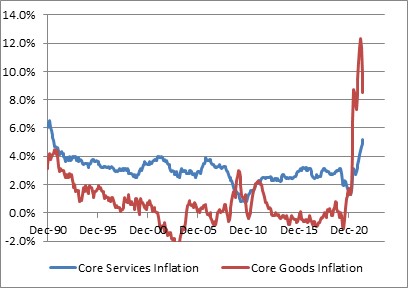
Core Services Inflation/Core Good Inflation
- Owners’ Equivalent Rent leapt +0.6% m/m and now at 5.1% y/y.
- Primary Rents +0.63%. I have to look back and see the last time we saw any m/m jump that big.
- Lodging Away From Home +0.9%. So Housing subcategory was +0.85% m/m, +6.9% y/y.
That was the biggest m/m change in OER since 1990. And it doesn’t look like it’s rolling over.
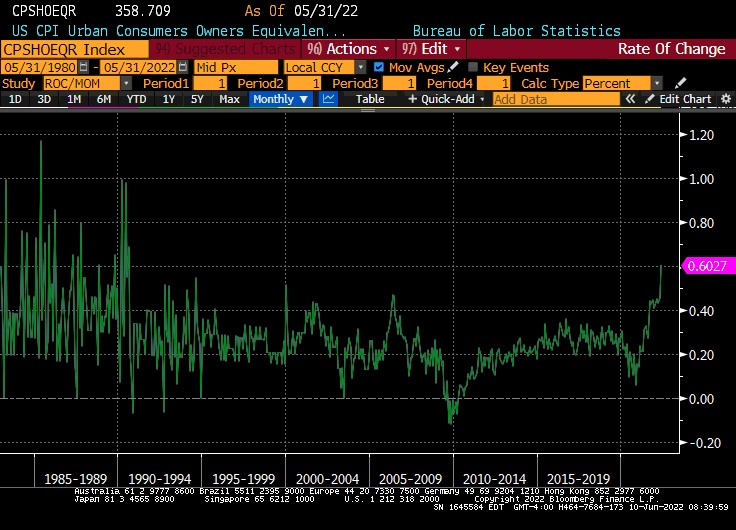
Doctors’ services fell -0.14% m/m and are at only +1.1% y/y. Amazing. Hospital services +0.46% m/m, so y/y went to 3.87%. Overall Medical Care subcategory was +0.4% m/m, to 3.74% y/y.
Core inflation, ex-housing, declined to 6.4% y/y. Yay!
This is kind of what I was afraid of. Housing inflation is moving above our model. It’s more in line with one of the subcomponents of the model, which is income-driven. And since wage income is still rising rapidly, there’s no reason to expect rents to slow very much.

Owner’s Equivalent Rent/Ensemble Forecast
Household energy was +3.96% m/m. Fuel oil +11% on the month, +76% y/y. Piped gas +7.8% m/m, +30.2% y/y. Electricity +1.9% m/m, +12% y/y. Break out those sweaters.
(That was an allusion to Jimmy Carter telling folks to turn down the thermostat and wear a sweater in the 1970s energy crisis).
So communication was -3.5% on the month. No idea what that is all about. Miscellaneous personal services was -1.3% m/m. Tenants and household insurance -0.8% m/m. Without that 5% of the basket declining, this would have been worse.
The median also looks like it should be 0.63% m/m or so. If true, that would be the biggest median since 1982. And folks, pressures aren’t ebbing; they’re building. Core highest in a year (m/m); median highest in decades.
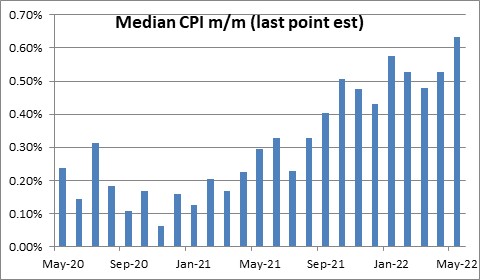
Median CPI M/M
About 8% of the consumption basket inflated faster than 9% annualized this month (m/m * 12, not y/y). That’s ridiculous. Normally there are a handful of outliers.
Four Piece Charts:
Piece 1: Food and Energy, no surprises.
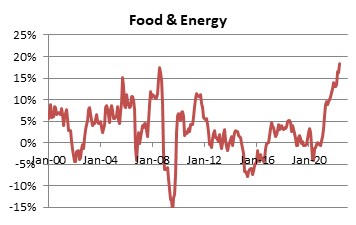
Food + Energy
Piece 2: Core goods. Like I said, good news. strength doesn’t hurt, but this ebbing is mostly due probably to declining trucking/shipping. Still not exactly soothing.
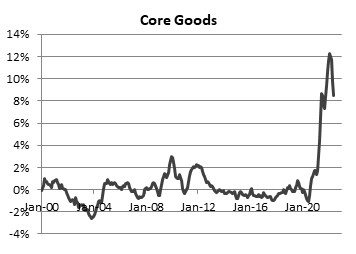
Core Goods
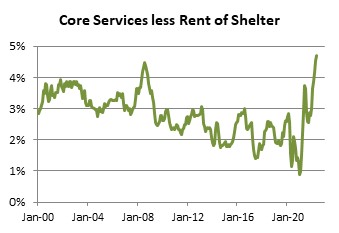
Core Services Minus Rent
Piece 4: Rent of shelter. I’ve already discussed. It’s taking the top of my model.
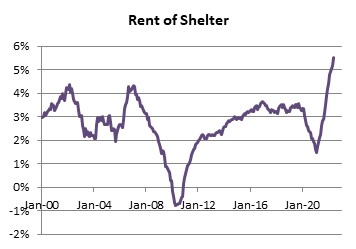
Rent Of Shelter
Bottom Line
As predicted, stocks are not loving this. The short end of the Treasury curve was also less than pleased.
I forgot: CPI for baby food was unchanged on the month, +12.75% y/y.
One more chart, and then I want to wrap up. The Enduring Investments Inflation Diffusion Index declined slightly this month but is still at a very high level. Those few weird negative categories might have rounded its edges a little. Nothing soothing, though.
So, look. Housing accelerating to new levels as a slow-moving category is really, really bad news. This was worse than even the pessimists were looking for.
Headline inflation, thanks to continued gasoline price rises, may advance further. Core inflation was down and may be down again next month, but only because of really rough comps. May 2021 (dropped off today) was +0.75%. June was +0.80%.
But then July, August, and September 2021, on core CPI, were +0.31%, 0.18%, and 0.26%. We’re going to shatter that. So core CPI probably doesn’t really peak until September…at best.
Meanwhile, Median CPI is still rising, months away from a peak also, and more importantly, still setting new highs in m/m prints. That’s amazingly bad news.
We all know the Fed is behind the curve. And we know that their 2.75% terminal dot was based on the assumption that inflation would ebb to a level they think is the natural equilibrium around 2.25%.
That isn’t going to happen. Now, that doesn’t mean they’ll hike rates to where they really need to be, but the choice between saving the nation from inflation on the one hand and saving the stock market on the other hand just got real.
Remember this chart. All of the models the Fed is using assume the can opener. They assume anchored expectations or some other potion pulls inflation to 2.25%. This is false.
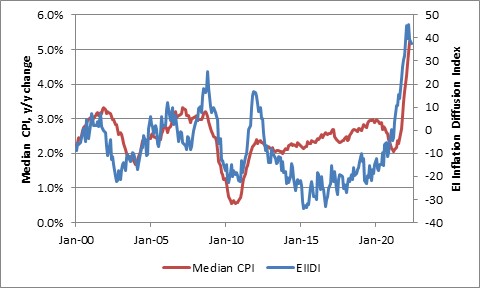
Median CPI YoY/El Inflation Diffusion Index
Every crisis has an inflection point where suddenly everyone realizes they’re on the wrong side of the boat – the day that our assumptions up to that point became plainly and wrong. In the global financial crisis, the day that Lehman failed (without being merged into some other firm like Bear was) was the day when the last sleeping people woke up. Maybe we will look back on this day and say,
So, peak CPI isn’t yet behind us. Some of that is gasoline, of course. But the core CPI figures were also stronger-than-expected and the strongest month in a year. Median CPI is still getting stronger every month, with new m/m records every month and y/y still rising. Rents are still accelerating. So not only are prices still rising, but inflationary pressures appear to be still rising even though there are some signs of improvement in some cases (notably in core goods).
Those pressures should eventually ebb if money supply growth remains flattish as it has over the last few months. But the price level has not yet caught up with prior increases in the money supply. Even after the microwave is turned off, the kernels in the popcorn bag still pop for a little while. That’s the best case at this point – we are witnessing the final kernel pops.


